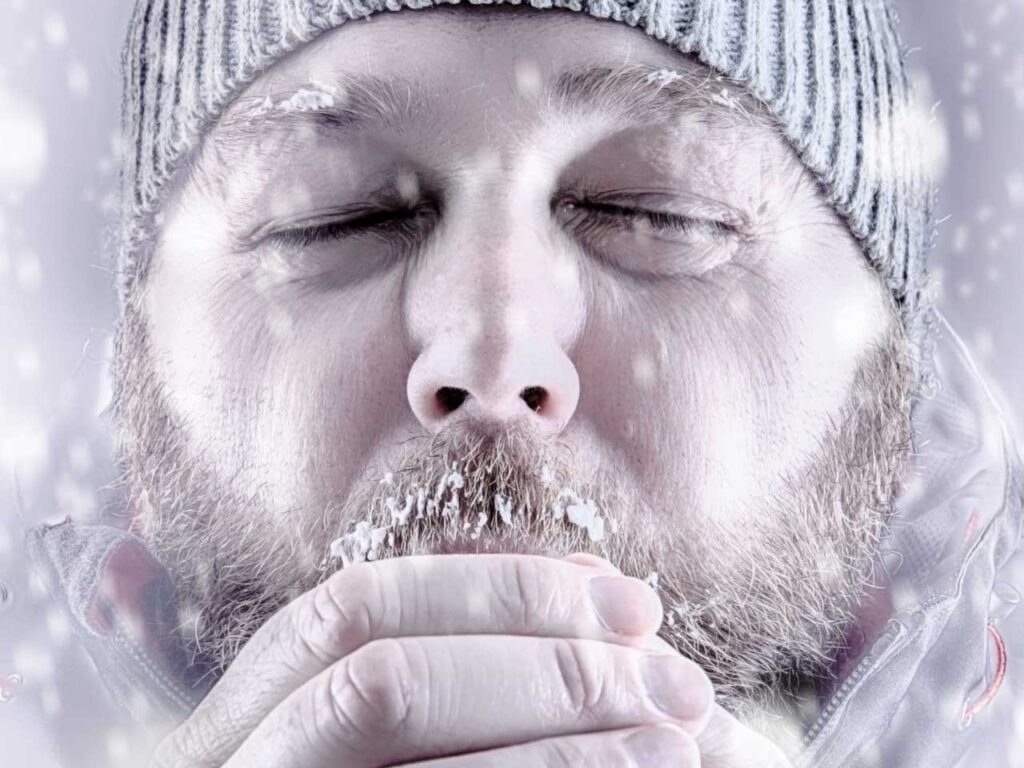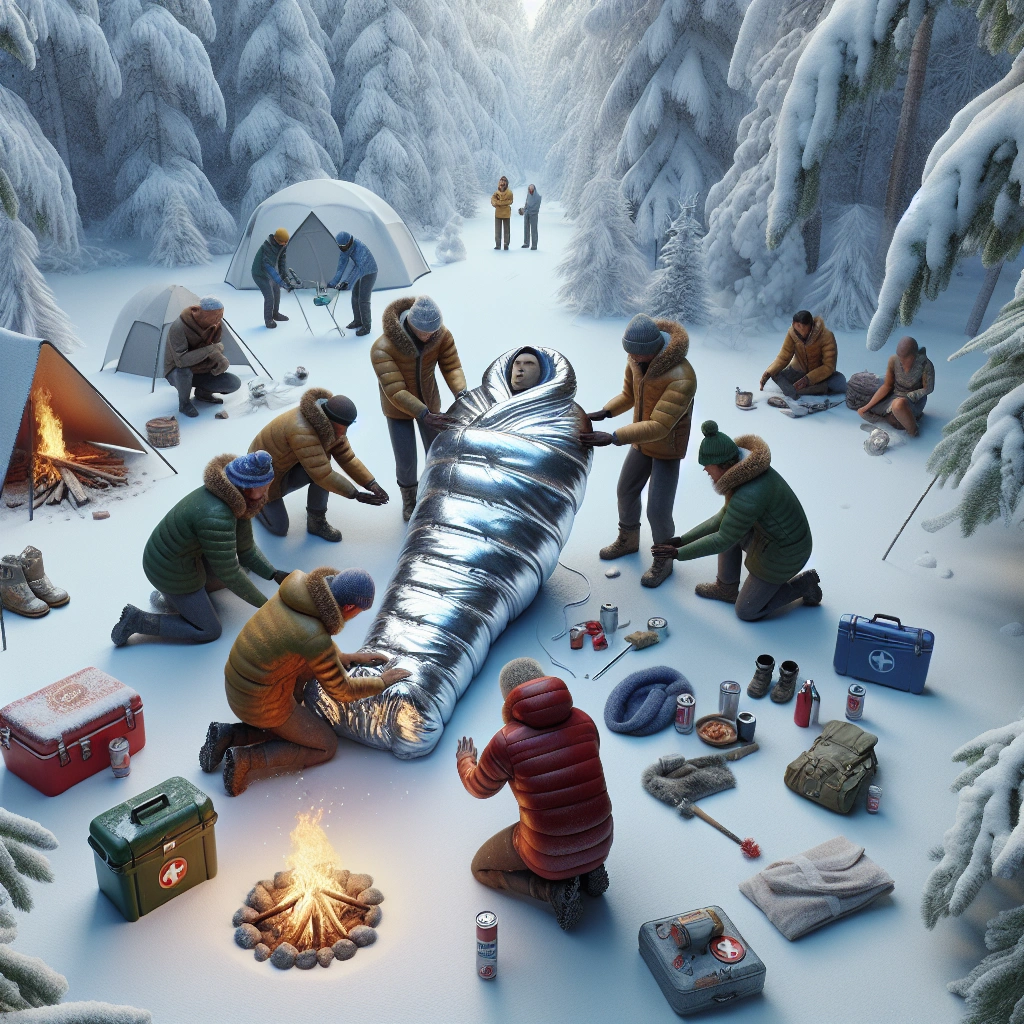

Hypothermia Prevention is crucial for avoiding the dangers of extreme cold. Left untreated, hypothermia can lead to serious health complications and even death.
Hypothermia Prevention involves wearing warm, multi-layered clothing with good hand and feet protection, avoiding overly constricting wrist bands, socks, and shoes, and drying out as quickly as possible when getting wet.
Understanding the basics of Hypothermia Prevention is key to staying safe in cold weather and preventing the risk of hypothermia.
Check out this Youtube video: Learn essential hypothermia prevention tips to keep yourself safe during outdoor adventures!
What is Hypothermia?
Hypothermia refers to a medical emergency that occurs when the body loses heat faster than it can produce it, causing a dangerously low body temperature. This can happen in extremely cold conditions or prolonged exposure to mild temperatures.
As the body temperature drops, it affects the body’s ability to function, leading to serious health complications. It is a condition that requires immediate attention to prevent more severe consequences.
Explaining the Definition of Hypothermia
Hypothermia happens when the body’s internal temperature drops below 95 degrees Fahrenheit (35 degrees Celsius). The body’s normal temperature is around 98.6 degrees Fahrenheit (37 degrees Celsius).
As the internal temperature decreases, it impacts various bodily functions, leading to symptoms like shivering, confusion, drowsiness, and in severe cases, loss of consciousness. The condition can be life-threatening if not addressed promptly.
Hypothermia is categorized into different stages based on the severity of the temperature drop. These stages include mild hypothermia (body temperature 90-95 degrees Fahrenheit), moderate hypothermia (body temperature 82-90 degrees Fahrenheit), and severe hypothermia (body temperature below 82 degrees Fahrenheit).
Each stage presents distinct symptoms and requires different levels of medical intervention.
The Effects of Hypothermia on the Body
Hypothermia adversely affects the body’s systems, leading to impaired cognitive function, reduced coordination, and, in severe cases, coma and death. As the body temperature drops, the heart rate and respiratory rate slow down, hampering the delivery of oxygen to vital organs.
If left untreated, hypothermia can result in cardiac arrest and ultimately lead to death. It’s crucial to recognize the signs of hypothermia and take immediate action to prevent further health complications.
Hypothermia also impacts the circulatory system, causing vasoconstriction, where blood vessels narrow to retain heat, leading to decreased blood flow to extremities and vital organs. This constriction can result in tissue damage and, in extreme cases, lead to frostbite.
Hypothermia Risk Factors and Causes
Numerous factors can contribute to the onset of hypothermia, including cold weather exposure, inadequate clothing, dampness, and wind chill. Certain demographics, such as infants and older adults, have a heightened risk due to decreased metabolic rates and diminished ability to regulate body temperature.
Moreover, medical conditions, substance abuse, and certain medications can also increase vulnerability to hypothermia.
Environmental factors, including cold weather and water immersion, play a significant role in causing accidental hypothermia. In addition, surgical procedures and anesthesia can lower body temperature, posing a risk for hypothermia development.
Understanding the risk factors and taking preventive measures is essential for averting the potentially life-threatening consequences of hypothermia.
Symptoms of Hypothermia
Hypothermia Prevention
Recognizing the Early Signs of Hypothermia
The early signs of hypothermia, often observed in mild cases, include shivering, an indication of the body’s attempt to generate heat. Moreover, individuals may experience exhaustion and a profound sense of fatigue due to the body’s struggle to maintain a stable temperature. Confusion and cognitive impairment are also indicative of early-stage hypothermia. Additionally, fumbling hands, memory loss, and slurred speech are warning signs of the body’s inability to regulate its internal temperature. Oftentimes, individuals may also display drowsiness, particularly if the hypothermia is slowly escalating.
Understanding the Advanced Symptoms of Hypothermia
As hypothermia progresses, individuals may exhibit more advanced symptoms, such as intense shivering or a complete cessation of shivering, which indicates a critical stage. The individual may also experience slow breathing, mental confusion escalating to a state of severe disorientation, and a significantly weakened pulse. These advanced symptoms signal a critical need for immediate medical attention and rapid warming of the body to prevent life-threatening complications.
Severe Complications of Hypothermia
Severe complications of hypothermia may arise if the condition is left untreated or if appropriate measures are not taken promptly. These complications may include the development of frostbite, leading to tissue damage due to prolonged exposure to extreme cold. In critical cases, cardiac arrhythmias and impaired heart function may occur, posing a significant risk to the individual’s life. Furthermore, there is a heightened susceptibility to hypoglycemia and impaired blood clotting, amplifying the severity of the situation.
Hypothermia Symptoms Summary Table
| Stage | Symptoms |
|---|---|
| Early Signs | Shivering, exhaustion, confusion, fumbling hands |
| Memory loss, slurred speech, drowsiness | |
| Advanced Symptoms | Intense shivering, slow breathing, mental confusion |
| Weak pulse | |
| Severe Complications | Frostbite, cardiac arrhythmias, impaired blood clotting |
| Hypoglycemia, increased risk of heart complications |
Importance of Hypothermia Prevention
Hypothermia Prevention
The Impact of Hypothermia on Health and Safety
Hypothermia, a potentially life-threatening condition caused by excessive heat loss, poses a grave danger to health and safety. The impact of hypothermia extends beyond plummeting body temperatures, as it impairs cognitive and physical function, leading to severe consequences.
Exposure to the cold can result in shivering, confusion, and slurred speech, making it imperative to prioritize hypothermia prevention to safeguard wellness and well-being. Hypothermia can escalate swiftly, particularly in vulnerable populations such as the elderly and infants, requiring proactive measures to mitigate its detrimental effects on health and safety.
Public Health Significance of Preventing Hypothermia
The prevention of hypothermia holds paramount significance in public health, considering its potential to lead to serious health complications and fatalities. By prioritizing hypothermia prevention strategies, individuals and communities can avert the dire consequences associated with this condition.
Public health initiatives focusing on education, preparation, and response protocols can effectively minimize the prevalence of hypothermia-related emergencies, thereby promoting overall well-being and safety in society.
Hypothermia Prevention as a Key Outdoor Safety Measure
Hypothermia prevention serves as a pivotal component of ensuring outdoor safety, especially in environments prone to cold temperatures and adverse weather conditions. Implementing measures such as wearing appropriate clothing, staying dry, and recognizing early symptoms of hypothermia are instrumental in safeguarding individuals engaged in outdoor activities.
It is crucial to emphasize proactive prevention methods, such as establishing emergency shelters and fostering community awareness, to mitigate the risks of hypothermia and uphold the safety of outdoor enthusiasts.
| Signs of Hypothermia | Prevention Strategies |
|---|---|
| Shivering | Dressing in warm, layered clothing |
| Confusion | Ensuring adequate hydration and nutrition |
| Slurred speech | Utilizing appropriate outdoor gear and equipment |
| Drowsiness | Engaging in ongoing outdoor safety training |
Hypothermia Prevention Essentials
Dressing Appropriately for Cold Weather
When it comes to dressing appropriately for cold weather, it’s crucial to start with a moisture-wicking base layer to keep sweat away from the skin. This base layer can be made of merino wool or synthetic materials like polyester or nylon. The middle layer should provide insulation, and options like fleece or down are highly effective. The outer layer should protect against wind and moisture, featuring waterproof materials with breathable properties. Additionally, it’s important to cover the head and hands to reduce heat loss and further enhance warmth.
Layering Clothing for Optimal Warmth
Layering clothing is a key strategy for optimal warmth in cold weather. This involves wearing multiple layers of clothing, each serving a unique purpose. To effectively layer, the first layer should be moisture-wicking, followed by an insulating layer, and finally, an outer layer that provides protection against wind and moisture. This layering approach helps trap warm air close to the body while managing moisture effectively.
Importance of Headgear in Hypothermia Prevention
The importance of headgear in hypothermia prevention cannot be overstated. The head is a major source of heat loss, and wearing a hat or beanie helps to preserve body heat. Additionally, a large portion of body heat is retained by wearing appropriate headgear, making it a crucial element of staying warm in cold weather conditions.
Use of Heat Packs and Body Warmers
In combating hypothermia, the use of heat packs and body warmers can play a pivotal role. These items provide essential supplementary warmth, particularly for the extremities, and can be utilized to restore warmth in case of exposure to cold for extended periods.
Proper Foot and Hand Protection
Proper foot and hand protection are imperative in preventing hypothermia. This involves wearing insulated and waterproof boots for the feet, along with moisture-wicking socks. For hand protection, insulated gloves or mittens are vital in shielding the hands from cold temperatures, wind, and moisture.
Strategic Packing for Water and Food
In cold weather, strategic packing for water and food is essential for both hydration and sustenance. It’s advisable to carry insulated containers to prevent water from freezing, and to pack high-energy, non-perishable food items. Maintaining hydration and nourishment is crucial to supporting the body’s natural heat production and regulation.
Choosing the Right Clothing Material
When it comes to selecting clothing for cold weather, considering the right material is pivotal. Fabrics such as merino wool and synthetic materials like polyester or nylon are excellent for moisture-wicking, while fleece and down provide effective insulation. Additionally, outer layers crafted from waterproof and breathable materials are crucial for protecting against the elements.
Limiting Alcohol Consumption in Cold Weather
Limiting alcohol consumption in cold weather is essential, as it can impair the body’s ability to regulate temperature. While alcohol may create a sensation of warmth, it actually causes blood vessels to dilate, resulting in increased heat loss from the body. Opting for warm, non-alcoholic beverages is a more effective approach to maintaining body temperature in cold conditions.
Safety Measures for Boating in Winter
In winter, adhering to specific safety measures for boating is critical. This includes wearing appropriate cold-water immersion suits and life jackets, as well as ensuring that boats are equipped with emergency supplies such as signaling devices, waterproof communication equipment, and navigational aids.
Importance of First Aid and CPR Training
Recognizing the importance of first aid and CPR training cannot be overstated, particularly in cold weather scenarios. Having the knowledge and skills to provide immediate assistance in cases of hypothermia or cold-related injuries can be life-saving. It’s crucial to undergo training to be proficient in administering first aid and CPR effectively in such conditions.
Tables make excellent choices for organizing and presenting data, statistics, or any tabular information. They provide a clear and systematic structure to present complex information in an easily consumable format.
Below is an example of a basic table.
| Heading 1 | Heading 2 | Heading 3 |
|---|---|---|
| Content 1 | Content 2 | Content 3 |
| Content 4 | Content 5 | Content 6 |
| Content 7 | Content 8 | Content 9 |
First Aid for Hypothermia
Emergency Response for Hypothermia
When facing a hypothermia emergency, it is crucial to act swiftly and deliberately. Start by assessing the situation and ensuring safety for yourself and the victim.
Call emergency services immediately by dialing 911 or the relevant local emergency number. While awaiting professional assistance, carefully move the individual to a warm and sheltered location.
Swiftly remove any wet clothing, and replace it with dry, warm garments. Next, use blankets, coats, or any available insulating materials to wrap the person, particularly focusing on the head and neck areas.
Promptly provide warm, non-alcoholic fluids such as tea or hot chocolate if the victim is conscious and can swallow safely.
Correct Practices for Treating Hypothermia
Treating hypothermia requires a systematic approach to rewarm the body safely. While waiting for medical help, use warm, dry compresses on the neck, chest, and groin of the victim to gradually raise their body temperature.
Additionally, carefully apply electric blankets, ensuring the settings are appropriate to prevent burns. If these tools are unavailable, use hot water bottles or a chemical hot pack, securely wrapped in a towel to avoid direct contact with the skin.
It is vital to regulate fluid intake by providing warm, sweet, and non-alcoholic beverages. Always monitor the individual’s condition closely and be prepared to administer CPR if necessary.
Necessary First Aid Supplies for Hypothermia
In preparation for treating hypothermia, it is essential to have a well-equipped first aid kit readily available. The kit should include dry and warm compresses or plastic fluid-filled bags, as well as blankets or insulating materials for effective warmth retention. Additionally, incorporate electric blankets and hot water bottles or chemical heat packs, ensuring proper insulation with towels. It is imperative to include a supply of warm, sweet, non-alcoholic drinks for ingestion. Furthermore, the kit should contain emergency contact information* and directions for administering CPR, as well as the necessary equipment for such interventions.
Hypothermia Prevention Resources
| Agency | Description |
|---|---|
| Centers for Disease Control (CDC) | Leading provider of practical and authoritative info |
| National Institute of Health (NIH) | Conducts and supports research to understand causes |
The Role of Public Health Organizations in Educating on Hypothermia Prevention
Public health organizations are pivotal in disseminating
Hypothermia Prevention
information. The World Health Organization plays a significant role in highlighting hypothermia as a preventable risk factor for newborn survival and provides recommendations to address this issue. Additionally, the American Red Cross takes an active stance in educating communities on hypothermia prevention during winter weather emergencies, providing comprehensive tips on recognizing and combating this life-threatening condition.
| Organization | Role |
|---|---|
| World Health Organization | Advocates the prevention of hypothermia as a newborn survival risk factor |
| American Red Cross | Provides community education on hypothermia prevention during winter weather emergencies |
Tips and Recommendations for Hypothermia Prevention from Experts
Experts in the field of medicine and emergency response offer invaluable tips to prevent hypothermia. Their guidance includes dressing appropriately for outdoor activities, using body warmers and heat packs as necessary, and minimizing skin exposure to cold weather.
Moreover, renowned professional bodies such as the Association of periOperative Registered Nurses (AORN) clearly outline preoperative interventions for surgical patients to prevent hypothermia, ensuring that best practices are disseminated effectively within the healthcare community.
| Expert Organization | Recommendations |
|---|---|
| Association of periOperative Registered Nurses | Provides preoperative interventions for surgical patients to prevent hypothermia |
Recommended Amazon Products for Hypothermia Prevention
Here’s a curated list of products that can help you prevent hypothermia with ease. These recommendations are based on functionality, price, and reviews.
Hypothermia Blanket


A hypothermia blanket is an essential item for preventing and treating hypothermia. It is designed to reflect and retain body heat, helping to maintain a person’s core body temperature.
Pros and Cons
| Pros | Cons |
|---|---|
| Reflects and retains body heat | Not reusable |
| Lightweight and portable | May not fit very tall people |
| Easy to use and store | Single-use item |
Electric Heated Vest


An electric heated vest is a practical and effective solution for preventing hypothermia in cold weather. These vests are equipped with heating elements that provide warmth to the body, making them ideal for outdoor activities in low temperatures.
Pros and Cons
| Pros | Cons |
|---|---|
| Adjustable heating levels | Limited battery life |
| Comfortable and lightweight | Requires charging |
| Can be worn under other clothing | Higher cost than regular vests |
Thermal Socks


Keeping your feet warm is essential for overall body warmth, especially in preventing hypothermia. Thermal socks are designed to provide insulation and comfort in cold conditions.
Pros and Cons
| Pros | Cons |
|---|---|
| Excellent insulation for the feet | May be too thick for some types of shoes |
| Moisture-wicking properties | Limited color and style options |
| Durable and long-lasting | More expensive compared to regular socks |
Hand Warmers


Hand warmers are disposable packets that produce heat when activated. These are great for providing immediate warmth to your hands, which is crucial for preventing hypothermia in cold conditions.
Pros and Cons
| Pros | Cons |
|---|---|
| Easy to use and carry | Single-use item |
| Provides quick warmth | Short lifespan |
| Convenient for outdoor activities | Added cost for replacements |
Insulated Water Bottle


Staying hydrated is key to maintaining body temperature, and an insulated water bottle helps ensure that your water stays at an optimal temperature in cold weather.
Pros and Cons
| Pros | Cons |
|---|---|
| Retains the temperature of its content | May be bulky to carry |
| Durable and long-lasting | Slightly more expensive than regular water bottles |
| Versatile for both hot and cold liquids | Limited color and design options |
Top Recommended Product for Hypothermia Prevention
If you’re looking for the best solution for hypothermia prevention, we highly recommend Hypothermia Blanket. Hypothermia blankets are a versatile and essential item for maintaining body temperature in cold conditions. With its ability to reflect and retain body heat, it provides an effective solution for preventing hypothermia in various outdoor activities.
Ready to improve your hypothermia prevention kit? Check out the Hypothermia Blanket


Frequently Asked Questions
What are 5 ways to prevent hypothermia?
How will you prevent hyperthermia?
How can you save hypothermia?
What are 3 first aid treatments for hypothermia?
What 4 things should you do to prevent hypothermia?
Reference Links
- https://www.hunter-ed.com/newyork/studyGuide/Hypothermia/20103502_138127/
- https://ffxfirerescue.wordpress.com/2022/01/07/dress-appropriately-for-cold-weather-learn-the-signs-and-symptoms-of-hypothermia-and-frostbite/
- https://www.cureus.com/articles/160798-quality-improvement-study-with-low-cost-strategies-to-reduce-neonatal-admission-hypothermia
- https://www.rei.com/learn/expert-advice/how-to-dress-in-cold-weather.html
- https://www.goodrx.com/health-topic/environmental/how-to-layer-clothes-for-prevention









